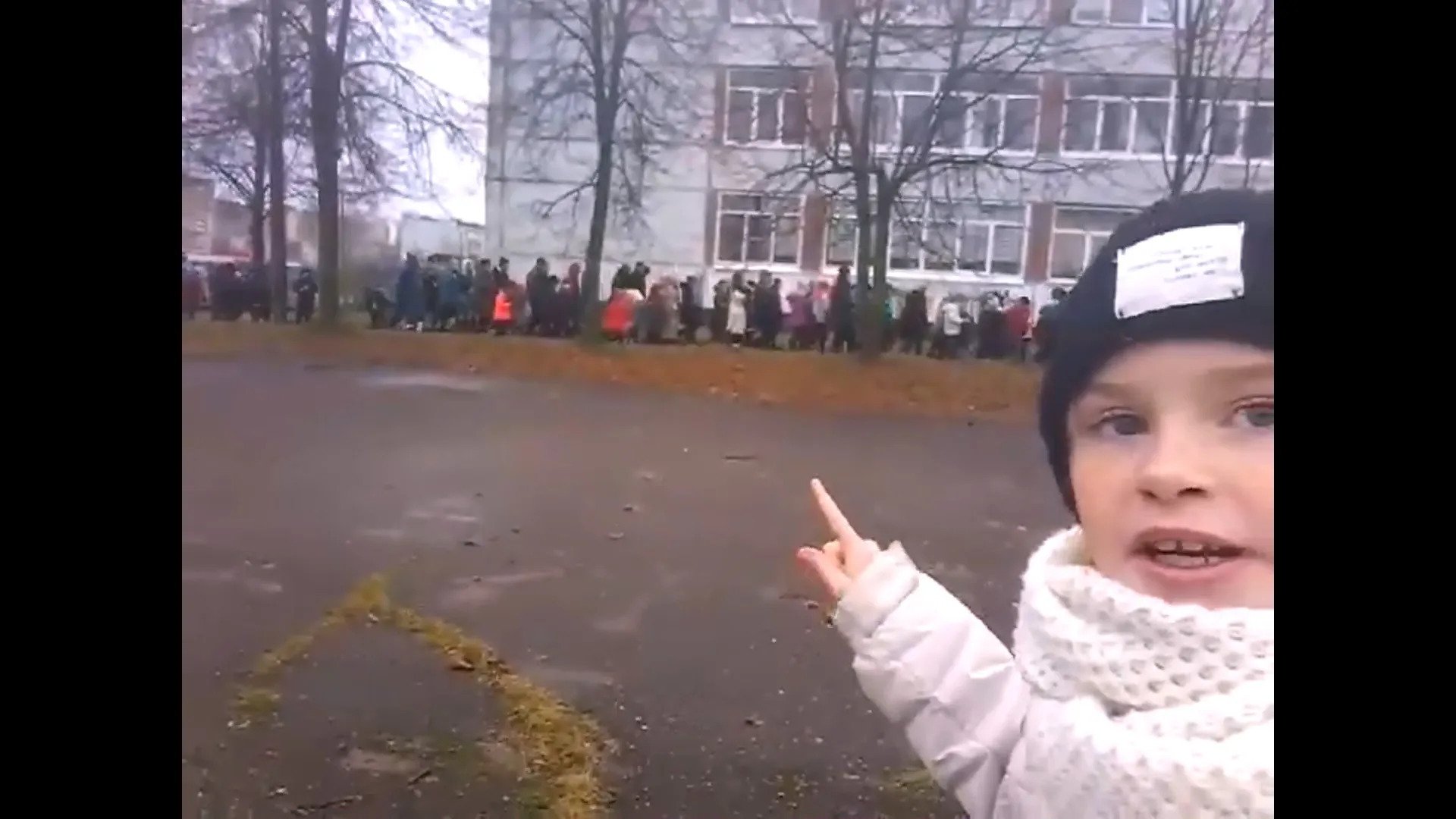This review contains discussion of school shootings, suicide, abuse, and other traumatic events.
The opening of Angie Vinchito’s devastating documentary Manifesto presents white clouds rolling across a harmless blue sky before that footage succumbs to a chorus of school children waking up and broadcasting their morning activities via social media. One child details how they brush their teeth (up and down, not side to side), another talks about their morning routine and how they have an hour to themselves before school commences. There is an air of freedom and energy that envelopes the morning exploits of these kids. Even though these children live in a modern world with all manner of social pressures and anxieties, they embrace the possibility of the day.
As Vinchito’s montage gently moves forward, we follow the kids as they trudge through the snow to get to school. Even with the biting cold of winter many carry a jovial nature in their voice as they continue to present a version of their lives on social media, whether it be via livestreaming on YouTube or presenting snippets of their day via TikTok. It’s not long before that positivity makes way for despair, as the sounds of wailing warning sirens floods the air, echoing along the streets, its pained yowling bouncing against the towering structures of the brutalist apartment buildings. One boy is overwhelmed with fear, with him being unsure where to run or move leading him to pivot in a circle on the spot, unable to decide if he should flee home or try make his way to school. We never see his choice play out. In a different clip, another child shouts in alarm that they’re under nuclear attack; Vinchito cuts to another child waving a handgun around in fear, waving off potential threats.
Here, the collated narrative of Manifesto moves into the classroom, where the horror of real-life trauma and tragedy is presented in a stark, stultifying manner as Vinchito folds in CCTV footage of teachers physically, verbally, and sexually abusing students. One student captures footage of their teacher, an older woman, condemning her class of girls to a life of servitude to the patriarchal society they live in. The teacher delivers a sermon to the class that they need to have sex with ‘their man’ whenever he wants, stating that a woman’s life is to cook, clean, and maintain their ‘hobbies’, all of which comes after the needs of ‘their man’. Another is told that they will be reprimanded for their left-leaning political views. This is a horrifying 1950s mindset being delivered in a modern school system.
From this point on, Vinchito’s editing never gives the viewer time to breathe as a shot of a young student being molested in a closet by a much older man quickly flits into an explosion of violence as the cacophony of clips blurs into one another, from school shootings to students jumping out of high level windows to avoid being shot to kids livestreaming their final moments as blood from their classmates pools around them.
As if this wasn’t enough violence for one film, Vinchito chooses to close Manifesto on an extended live stream of a couple who have holed themselves up in a house and gee themselves up to either fight the police or commit suicide. The two joke about their lives, about what they’re doing, and how there is simply no future for them at all in the world, before taking their lives off screen. In a closing motif, Vinchito presents the same blue sky and clouds that opened the film, as if to say, ‘we may all live under the same sky, but these are the events that are happening in our neighbourhoods to our children.’
In the decades since the Columbine massacre in 1999, footage of school shootings and their traumatic aftermath have become common place on social media and the news, with the rapid frequency of these events creating a numbing effect. They still leave a mark, and continue to shock, upset, and tear apart communities, but their almost daily frequency makes it’s hard to ever recover, heal, and grow between events. Ultimately, Manifesto is more disturbing and unsettling than any horror film ever could be, as viewers are left with the painful experience of feeling their soul being crushed as traumatic event flows into traumatic event.
After reading about the school shootings, the noxious misogyny, the stifling of political perspectives, and the destructive landscape that children are raised in, I now want you to imagine that the country these events have taken place in is Russia.
Manifesto is a distinct collage about modern Russia, with Vinchito using the edited footage to hold truth to power and question the notion of what it is we actually mean globally when we say, ‘the children are our future’. It’s difficult to not be aware of the disturbing similarities between modern Russia and modern America, with the ‘land of the free’ also falling victim to the same society-destroying events as shown throughout Manifesto. Just because these events take place in a country that violently and cruelly harms its own people does not mean that those who live outside Russia are better, safer, or able to condemn what is depicted on screen here.
The children use their phones as weapons, capturing their lives and acting as witness to the enduring tragedy they endure. Vinchito, as editor, creates an endurance test for viewers, one that makes for a supremely uncomfortable viewing experience. This is, after all, the intention of Manifesto, and it’s within that intention that it’s important to note the power of an editor and their ability to control and corral a manufactured narrative from the array of footage they work with. Again, this is ‘found footage’, retrieved from the internet and condensing almost a decade of the lives of Russian children into a 70-minute experience. It is easy to assume that one could also craft a film that covers the same span of time, from the same youthful documentarians, that presents a positive stance of the lives that the children of Russia experience. This is, after all, a slice of propaganda.
Angie Vinchito is a pseudonym, a hidden figure who obscures their face at the beginning of the film in an address to the audience as they talk about the purpose of Manifesto (Манифест). As the hooded, masked figure talks, a still of youth standing in the snow around a coffin looms large behind them. Within the coffin is the ‘future of children’. However, the anonymity that Vinchito affords themself is not extended to the children within the film, with none of the faces, voices, or locations being blurred, obscured or hidden in any way. The credits list is made up of the titles of the YouTube videos, again providing another identifying marker.
While this would otherwise be a cause for concern – given the brutal nature of the Russian government –, the reality is that the ‘always on’ lives that we lead nowadays means that the notion of anonymity on the internet is a dream. When we broadcast our lives via YouTube or TikTok, we open ourselves up to societal and government scrutiny, whether it be Russia, China, America, or any of the other nations on this place we call Earth. While we’re never advised whether consent was given to include each of these clips in the final film from those who captured the footage, we are left with the impression that by bearing witness to what these children have endured we have played a part in acknowledging and accepting the fractious and fractured lives they lead.
It’s easy to forget that while Russia engages in an illegal invasion of a neighbouring nation that there is still a country trying to live their lives, with Manifesto then acting as a salient reminder that not every Russian agrees with Putin’s actions, with many protesting or disrupting in their own way against his regime. Manifesto is horrifying, soul-shaking viewing, but it is also a brutal reminder that the violence that occurs on a daily basis around the globe – whether it be in school rooms, the streets, our workplaces or our homes – is not normal and we must never allow to become complacent about its existence.
Editor: Angie Vinchito
IDFA 2022 | Trailer | Manifesto from IDFA on Vimeo.



